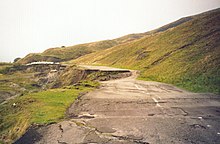

Subsidence is a general term for downward vertical movement of the Earth's surface, which can be caused by both natural processes and human activities. Subsidence involves little or no horizontal movement,[1][2] which distinguishes it from slope movement.[3]
Processes that lead to subsidence include dissolution of underlying carbonate rock by groundwater; gradual compaction of sediments; withdrawal of fluid lava from beneath a solidified crust of rock; mining; pumping of subsurface fluids, such as groundwater or petroleum; or warping of the Earth's crust by tectonic forces. Subsidence resulting from tectonic deformation of the crust is known as tectonic subsidence[1] and can create accommodation for sediments to accumulate and eventually lithify into sedimentary rock.[2]
Ground subsidence is of global concern to geologists, geotechnical engineers, surveyors, engineers, urban planners, landowners, and the public in general.[4] Pumping of groundwater or petroleum has led to subsidence of as much as 9 meters (30 ft) in many locations around the world and incurring costs measured in hundreds of millions of US dollars.[5] Land subsidence caused by groundwater withdrawal will likely increase in occurrence and related damages, primarily due to global population and economic growth, which will continue to drive higher groundwater demand.[6]
- ^ a b Jackson, Julia A., ed. (1997). "subsidence". Glossary of geology (Fourth ed.). Alexandria, Virginia: American Geological Institute. ISBN 0922152349.
- ^ a b Allaby, Michael (2013). "subsidence". A dictionary of geology and earth sciences (Fourth ed.). Oxford: Oxford University Press. ISBN 9780199653065.
- ^ Fleming, Robert W.; Varnes, David J. (1991). "Slope movements". The Heritage of Engineering Geology; the First Hundred Years: 201–218. doi:10.1130/DNAG-CENT-v3.201. ISBN 0813753031.
- ^ National Research Council, 1991. Mitigating losses from land subsidence in the United States. National Academies Press. 58 p.
- ^ Monroe, James S. (1992). Physical geology : exploring the Earth. St. Paul: West Pub. Co. pp. 502–503. ISBN 0314921958.
- ^ Herrera-García, Gerardo; Ezquerro, Pablo; Tomás, Roberto; Béjar-Pizarro, Marta; López-Vinielles, Juan; Rossi, Mauro; Mateos, Rosa M.; Carreón-Freyre, Dora; Lambert, John; Teatini, Pietro; Cabral-Cano, Enrique; Erkens, Gilles; Galloway, Devin; Hung, Wei-Chia; Kakar, Najeebullah (January 2021). "Mapping the global threat of land subsidence". Science. 371 (6524): 34–36. Bibcode:2021Sci...371...34H. doi:10.1126/science.abb8549. hdl:10045/111711. ISSN 0036-8075. PMID 33384368.